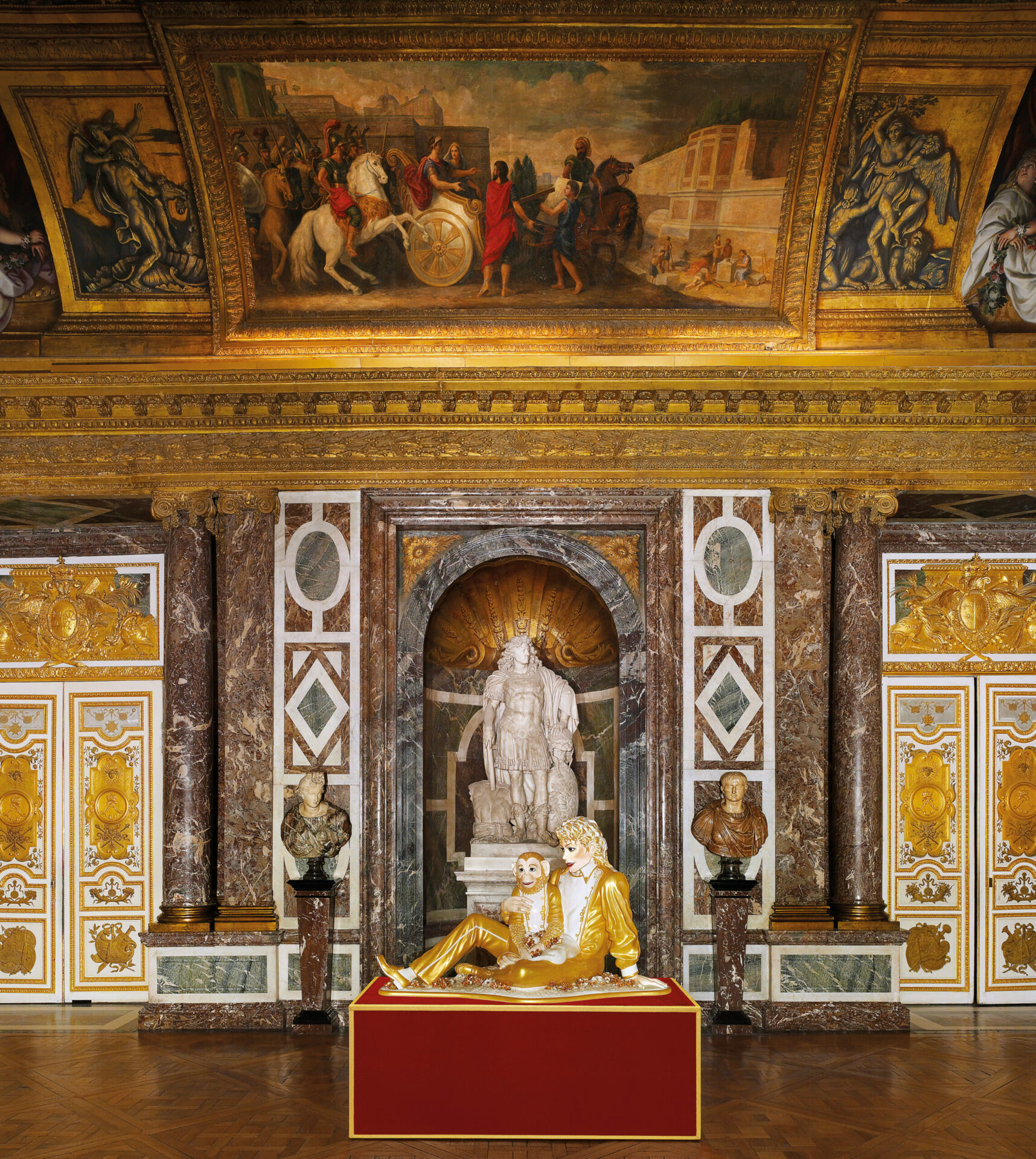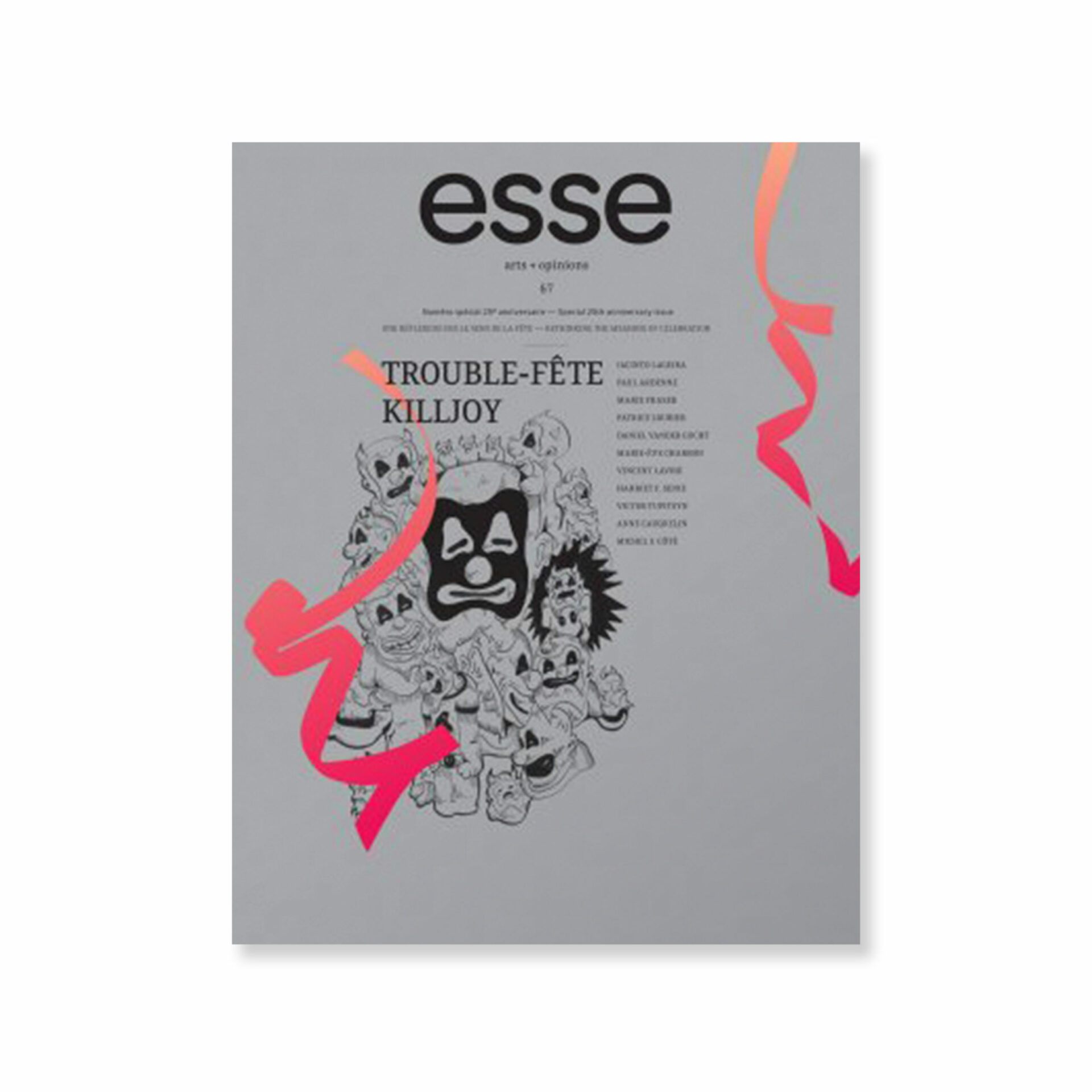
photo : Laurent Lecat assisté par | assisted by Ruy Ribiere © Jeff Koons
As early as 1939, in Le sacré de transgression: Théorie de la fête,1 1 - Roger Caillois, “Le sacré de transgression: Théorie de la fête” (1939), Œuvres (Paris: Gallimard [Quarto], 2008). Roger Caillois had deplored the loss of the full sense of celebration—“a paroxysm of society ”—as it gave way to the leisure class and mass culture. For, “as they evolve, societies tend toward indifferentiation, uniformity, a general levelling and easing of tensions. Society, increasingly complex, becomes less tolerant of interruptions in the normal course of life. Everything must go on today as it did yesterday, and tomorrow as it does today. General disruption is no longer possible. It no longer takes place on fixed dates, nor on a large scale. It is diluted, so to speak, through the calendar year, absorbed into the monotony, the regularity of a schedule. ‘Celebrations’ become holidays.”2 2 - Ibid., 289. This analysis is all the more compelling today upon observing the sheer number of celebrations throughout the world—Gay Prides, music festivals, all-nighters, concerts, carnivals, street entertainment, parades of all kinds, raves, and even the quintessentially Parisian “Paris plage”—all thoroughly harmonized with the state apparatus. Everything is carefully orchestrated by the authorities, with the help of “merrymakers” and “revellers,” so that things don’t go overboard, don’t change, don’t explode, and crowds don’t get jostled by revolution or revolt. We are at a cathartic time of globalization, where the death of a multimillionaire American pop singer can galvanize the whole world and bring it to tears more effectively than the desperate cries of the billion human beings now dying of hunger. Celebrations no longer transgress. They exist to make us forget true hardships, pain, catastrophes. To obliterate, hide, evade—or, in psychological terms, to deny and suppress—, such, today, are the functions of celebration, with the blessings of neoliberalism. This is no caricature: a little after the April 6, 2009, earthquake hit L’Aquila (capital of the Abruzzo region), “il Cavaliere” Berlusconi, Prime Minister of Italy, quite publicly told the 17,000 victims who now depended on government aid that they “lacked nothing. They have medical aid. They have hot food. Of course, their current lodgings [tents] are a bit temporary. But they should consider it like a weekend camping.” If you are in no mood for celebration, because you’re mourning the dead, the disappeared, the wounded, you must nonetheless put on a festive, convivial face and show community and national spirit. The festive may come into play anywhere, at any time, on any and all topics, like the Mother Theresa of revellers.
I don’t see that “celebrations of contemporary art” in their explicitly celebratory incarnations (openings, launches, inaugurations) are any different than the events by which works of art are brought forward. Considering the millions, public and private, that are regularly spent on the biennial and triennial packaging of contemporary art throughout the world, on foundations, on exported museums—the Louvre to Abu Dhabi, the Musée national d’art moderne/Centre Pompidou, also to Abu Dhabi, and soon to Shanghai—, and of course on the transparently named Fairs, little money ever goes to the authors, journals, editors, and emerging artists, the very substance and life force of the art world. And for good reason, since the court celebrations these generosities are given to—think of the Jeff Koons exhibition, among others, at Versailles—are so much more important and magnificent than any alternative venue or small-time publisher. Are these financial liberalities actually useful or effective?
For indeed, the problem must be cast in terms of utilitarian philosophy. With respect to contemporary art, father of utilitarianism Jeremy Bentham’s famous phrase may take a peculiar and unexpected turn: the greatest aesthetic good for the greatest number of people. By this reasoning, maximizing the aesthetic well-being of those who already possess a comfortable dose of it can have beneficial effects on those who have less.
The computation of pleasure and pain within contemporary art propels mass culture and the great festive congregations to the very edge of this sought-after aesthetic well-being, such that an increase in pleasure will always be more advantageous for the one with access to it while diminishing pain for the one on which this will end up having an effect. If a good number of people benefit from the celebration, such benefits will gradually accrue to the majority. It is a delusion coupled with a lie. The celebration of art isn’t as democratic as one might think. It makes rational attempts to maximize aesthetic well-being for the greatest number without ever really intending to do so. In the dissemination of mass culture, indeed designed for the greatest number of people, it isn’t the latter’s well-being that is being sought so much as its stupefaction, so as to increase the material well-being of the owners of capital. We know perfectly well, to take a well-known example, that the Rio Carnival has become a staged spectacle of the poor for the benefit of the rich, who return from it all the richer as they will have maximized their aesthetic well-being, while the poor, remaining in their favelas, will not have benefited in the least. People will come back the next year for a parade still more beautiful and festive. All the more beautiful and festive that it will be led by those who have absolutely nothing and still manage to be festive. As long as they remain poor. As every tourist knows, the Brazilians are perennially merry and have samba running through their veins.
A deeply-rooted idea in contemporary art—in fact, an extremely tenacious remnant of the bourgeois ethos—assumes that, because it is art (the more so that it is contemporary), it is automatically a source of pleasure, happiness, joy, and well-being. Contemporary art is, in every sense of the term, the celebration of body and mind, though the claimed and clearly represented hedonism isn’t always the most straightforward path toward this new form of Buddhist awakening. Art is useful to our aesthetic well-being even when it shocks, repels, or offends our sensibilities, since its amorality and immorality are accepted as festive transgression in the archaic sense. We are no longer in the Stone Age, however, but in the age of ultra-liberalism. Art is nonetheless most anachronistically understood as the sole locus of transgressive celebration, which explains why a growing number of creative people of all types, with backgrounds having nothing to do with issues of art and aesthetics, claim an artistic prerogative to broach that enviable territory of the “art world.” One surprising quality of this world is that while it is overflowing with useful resources and processes for maximizing one’s well-being, it is itself useless. It has no end, no ending, no ultimate goal, and no defined form—a pretty faithful materialization of what the reveller seeks: celebration for celebration’s sake. Regardless of the means and the people involved, one must disrupt the senses, transgress to transgress, overcome every limit that presents itself. These festive transgressors forget that transgression itself is already conceived as its own innocuous overcoming, and thus the exact opposite of the transgressive action thought to be engaged.

Jeff Koons, Michael Jackson and Bubbles, 1988.
photo : Laurent Lecat assisté par | assisted by Ruy Ribiere © Jeff Koons
In presenting itself as a mammoth celebration open to all, in that art—like celebrations of old—is said to allow what is prohibited elsewhere, the latter is steered away from disinterestedness and its attendant autonomy, not to improve your psychological well-being so much as to channel the pleasures into a veritable arithmetic of hedonism that serves to commercialize practices that were meant to be immaterial, unquantifiable, immeasurable. The implementation of contemporary art is most subtle: intermingling symbolic value, use value, and exchange value, its utility is in no way free (in the monetary sense), since it always arises from the egotistical computation of pleasure and pain whose promised profitability through maximization speaks for itself.
The subjectivism and relativism of aesthetic tastes and preferences prevailing today are just another facet of rationalist utilitarian behaviour: I basically pursue whatever maximizes my aesthetic well-being and nobody can prevent me from doing so. That which appears to be the voice of pluralism and democratic reason, culminating in the quasi-communion of everyone with everyone in celebration, is another version of Adam Smith’s free-trading “invisible hand”: as everyone pursues their own pleasure and aesthetic maximization, without realizing it, so to speak, it is invariably beneficial to the community as a whole. Once the individual is aestheticized, aestheticization may be extended to groups and thus to all of society. As they say, “the more the merrier.” Art’s first use, or usefulness, then, would be to function as a liberating celebration, though we should be asking ourselves if art must be useful for anything at all, and if so, if it should be taking over the age-old uses of celebration, in particular that of at least temporarily upsetting values. Rather, celebratory contemporary art reinstates repressive values, for, by definition, its hedonistic utility cannot be rendered without generating a material and symbolic surplus value that is returned to the cultural industry—which has never so effectively earned its name.
Art, as such, is antithetical to quantification, calculation, and the computation of pleasures. To say that one work of art affords more pleasure than another is either a triviality of everyday language, or does indeed reveal that one can quantify the surplus value it is supposed to contain. This poses no problem for those who hold to the maximization of aesthetic well-being, since it is individual pleasure that is logically self-measured by the individual undergoing the experience. For those who hold that aesthetic judgement hinges on the immaterial value of art, things are very different. Conceived and experienced as immaterial, it cannot be quantified by anything or anybody at all. The essential tenor of art is thus its immateriality, even if the object that bears this aesthetic value is, as any object would be, concrete, purchasable, resalable, perishable. This object has a price, but the work of art born by this object has no price, in the literal sense. How do you quantify the aesthetic value of the works of a Bruce Nauman, Gerhard Richter, or Daniel Buren? Aesthetic value cannot be reduced to the material and tangible characteristics that make up these works. It would be absurd—and indeed futile—to attempt it. Art, as the field of the immaterial, implies an entirely different rapport between receivers and the works, and between the receivers themselves, with respect to the destination of these works. Art may be considered a celebration, provided one changes the aesthetic relationship. Not the useful and utilitarian aesthetic of our societies, but what I call an “aesthetics of the gift.”
This aesthetics of the gift has yet to be developed. The more so in that Marcel Mauss’ celebrated Essai sur le don (“The Gift,” 1923-24) says deliberately little about its aesthetic implications, and these issues are scarcely touched upon in the work of researchers at MAUSS (Mouvement Anti-Utilitariste en Sciences Sociales, or Anti-Utilitarian Movement in the Social Science), founded in 1982 by sociologist Alain Caillé. The framework of an aesthetics of the gift is built around the primacy of the processes of giving, receiving, reciprocating found in other social forms. Here, it isn’t individual exchanges but collective ones that prevail, and, as it is a matter of cultural productions, emphasis is placed on their immaterial, or symbolic value. With the gift, one no longer maximizes individual well-being but freely (and gratuitously) addresses the Other, the others, in a disinterested manner, the work of art essentially being an address to the Other comprising an obligation to reciprocate that is fulfilled by the critic. An artwork having no critical attention does not exist. Rather than be part of the process of production, transaction, consumption, the aesthetics of the gift proposes one of presentation, reception, critique. A true celebration of art or of aesthetic relationships would not derive profit, interests, or uses other than those of its immateriality, what Kant called “finality without end.” If the finality of art, or its function, is not to have any, why address it to the Other as a gift through a gesture that implies reciprocity? Do we not risk playing on words and actions, in as much as presenting-receiving-critiquing is still a means of acquiring benefits, though they be immaterial, aesthetic, artistic, and have no end at all? But, as with the gift in its other forms, the aesthetic gift is a commitment ensuring human freedom. No-one is constraining me, no-one imposes this action against my will; I choose to act with and for the other, and this is conditional on nothing but establishing the immateriality of our aesthetic interactions and thus ensuring art’s freedom of action, its autonomy. Yet this autonomy is impure, it must grapple with society while, simultaneously, the immaterial value seeks to maintain its autotelic nature, without which no free aesthetic thought could exist.
To the extent that art is this gift and this immaterial rendering, it is simultaneously interesting and disinterested. It also engages a moment of ethicity, in that the works are not neutral, they still signify. As one may observe at every contemporary art event, great and small, revellers readily drop the semantics of the artworks, their socio-political and ethical ramifications, to more fully give themselves over to celebrative abandon. Sometimes the reverse occurs, in a perfectly false reconciliation: on the pretext that the work is shocking, it is said to be more liberating. “More liberating”? How does one calculate that? Going to see works to liberate oneself is proof manifest that freedom cannot be found in practical and moral existence—otherwise, why seek it in art? But here too lies a bitter disappointment: the majority of those attending art shows are not even looking at the works, unless they are actively engaged in understanding and interpreting them; consequently, they are not returning to the world of art what the works had freely given. One is free to not appreciate a particular work and to criticize it in the negative sense, with supportive arguments, but this fulfils at least the return address to the Other. One would be overly naive to think that an aesthetics of the gift could mend each and everyone’s artistic, aesthetic, and ethical deficiencies, or that it might be the vector for a connecting bond between individuals. The gift cannot be made instrumental without immediately being reduced to nothingness. Art as celebration, if it is an unconditional and selfless gift between human beings, would thus still be deceptive, not only because everything in art is not of equal value and all celebrations are not of the same calibre, but especially because celebrations themselves have a negative dimension: art is not just pleasure and happiness. One gives in order to assert the freedom of the human community, not to use that community to serve one’s personal celebration.
[Translated from the French by Ron Ross]



